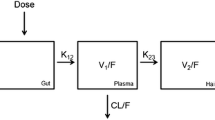Summary
Hair samples and morning pre-dose plasma were collected from 40 patients who had received fixed daily doses of haloperidol for more than four months and whose compliance was good. After washing, 1 to 2 cm-long portions nearest to the roots of 2 to 3 strands of hair were completely dissolved in 2.5N NaOH. Haloperidol in that sample or alkalinised plasma was extracted and measured by RIA.
Haloperidol concentrations in hair correlated well both with the trough concentration in plasma at steady-state (r=0.772,n=39) and with the daily dose (r=0.555,n=40). Another keratinized tissue, nail, was also collected from 20 of the 40 patients and the haloperidol level was compared with that in hair. The former was only about 4.3% of the latter and was significantly correlated only with the daily dose (r=0.525,n=20).
Hair from 10 other patients in whom the dosage of haloperidol had been changed within a few months prior to sampling the hair was cut into 0.5 or 1 cm-long portions from the roots and the drug concentration in each portion was measured. If hairs were assumed to grow at 1 cm/month, a history of individual dosage could be deduced in 9 of the 10 patients from the distribution of drug level along the length of the hair.
The results suggest that human scalp hair could serve as a useful tool for monitoring individual dosage history over several months, or in demonstrating exposure or non-exposure of a patient to a drug.
Similar content being viewed by others
References
Dahl SG (1986) Plasma level monitoring of antipsychotic drugs: Clinical utility. Clin Pharmacokinet 11: 36–61
Kopito L, Briley AM, Schwachman H (1969) Chronic plumbism in children: Diagnosis by hair analysis. J Am Med Assoc 209: 243–248
Weiss D, Whitten B, Leddy D (1972) Lead content of human hair (1871–1971). Science 178: 69–70
Taubaki T (1971) Clinical and epidemiological aspects of organic mercury intoxication. In: Smith H (ed) Proceedings of Symposium on Mercury in Man's environment. Royal Society of Canada, Ottawa
Al-Shahristani H, Al-Haddad IK (1973) Mercury content of hair from normal and poisoned persons. J Radioanal Chem 15: 59–70
Jervis RE, Tiefenbach B (1971) Trace mercury determinations in a variety of foods. In: Vogt JR, Meyer W (eds) Nuclear methods in environmental research, vol. 1. Columbia, University of Missouri
Schroeder HA, Nason AP (1969) Trace metals in human hair. J Invest Dermatol 53: 71–78
Chattopadhyay A, Roberts TM, Jervis RE (1977) Scalp hair as a monitor of community exposure to lead. Arch Environ Health 32: 226–236
Rimon R, Averbuch I, Rozick P, Fijman-Danilovich L, Kara T, Dasberg H, Ebstein RP, Belmaker RH (1981) Serum and CSF levels of Haloperidol by radioimmunoassay and radioreceptor assay during high-dose therapy of resistant schizophrenic patients. Psychopharmacology 73: 197–199
Suzuki H, Minaki Y, Iwaisaki M, Sekine Y, Kagemoto A, Utsui Y, Hashimoto M, Yagi G, Itoh H (1980) Determination of haloperidol in human serum by radioimmunoassay. J Pharm Dyn 3: 250–257
Wurzburger RJ, Miller RL, Marcum EA, Colburn WA, Spector S (1981) A new radioimmunoassay for haloperidol: Direct measurement of serum and striatal concentrations. J Pharmacol Exp Ther 217: 757–763
Poland RE, Rubin RT (1981) Radioimmunoassay of haloperidol in human serum: correlation with serum prolactin. Life Sci 29: 1837–1845
Forsman A, Oehmen R (1976) Pharmacokinetic studies on haloperidol in man. Curr Ther Res 20: 319–336
Forsman A, Oehmen R (1977) Studies on serum protein binding of haloperidol. Curr Ther Res 21: 245–255
Magliozzi JR, Hollister LE, Arnold KV, Earle GM (1981) Relationship of serum haloperidol levels to clinical response in schizophrenic patients. Am J Psychiatry 183: 365–367
Baumgartner AM, Jones PF, Black CT (1981) Detection of phencyclidine in hair. J Forensic Sci 26: 576–581
Smith FP, Pomposini DA (1981) Detection of phenobarbital in blood-stains, semen, seminal stains, saliva, saliva stains, perspiration stains and hair. J Forensic Sci 26: 582–586
Pueschel D, Thomasch P, Arnold W (1983) Opiate levels in hair. Forensic Sci Int 2: 181–186
Suzuki O, Hattori H, Asano M (1984) Detection of methamphetamine and amphetamine in a single human hair by gas chromatography/chemical ionization mass spectrometry. J Forensic Sci 29: 611–617
Barman JM, Astore I, Pecoraro V (1965) The normal trichogram of the adult. J Invest Dermatol 44: 233–239
Griffiths WAD, Reshad H (1983) Hair and nail growth: An investigation of the role of left- und right-handedness. Clin Exp Dermatol 8: 129–133
Montagna W, Parakkal PF (1974) The structure and function of skin (3 rd edn). Academic Press, New York
Kligman AM (1961) Pathologic dynamics of human hair loss. I. Telogen effluvium. Arch Dermatol 83: 175–180
Moroharu R (1979) Therapeutic drug monitoring of haloperidol. Jpn J Clin Psychiatry 8: 436–440 (in Japanese)
Ryan DE, Holzbecher J, Stuart DC (1978) Trace elements in scalp-hair of persons with multiple sclerosis and of normal individuals. Clin Chem 24: 1996–2000
Takashima I (1987) Development and alteration of human pelage. In: Kobori T, Montagna W (eds) Hair medicine. Bunkodo Tokyo
Author information
Authors and Affiliations
Rights and permissions
About this article
Cite this article
Uematsu, T., Sato, R., Suzuki, K. et al. Human scalp hair as evidence of individual dosage history of haloperidol: method and retrospective study. Eur J Clin Pharmacol 37, 239–244 (1989). https://doi.org/10.1007/BF00679777
Received:
Accepted:
Issue Date:
DOI: https://doi.org/10.1007/BF00679777




